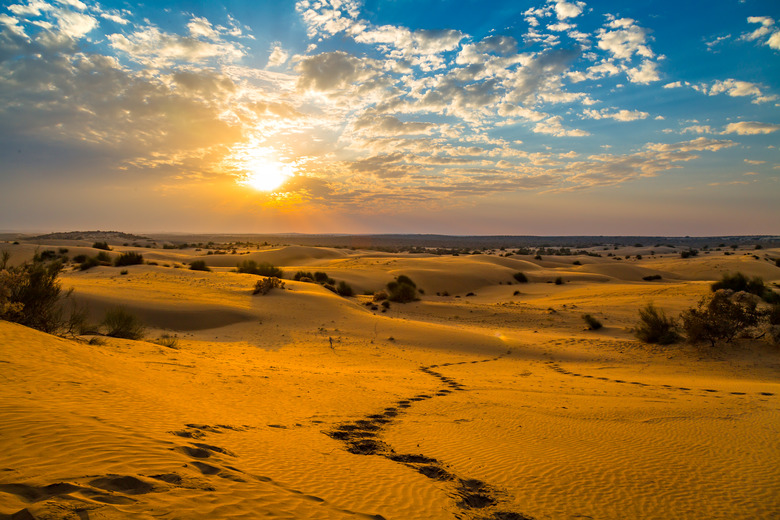List Of Deserts In India
India serves as home to multiple desert biomes, each of which exhibit distinctive ecological communities. The Thar Desert, one of India's largest, stretches from Rajasthan state in northwestern India to the Punjab and Sindh provinces in Pakistan. India has prominent arid regions in the northwestern, western and southern part of the subcontinent.
The Thar Desert
The Thar Desert
Also known as the Great Indian Desert, this arid region covers about 92,200 squares miles and is the seventh largest desert in the world. The name Thar comes from t'hul, a term for this desert's characteristic sand ridges. About 10 percent of the Thar Desert contains sand dunes, while the rest is formed of craggy rocks, dry salt-lake beds and grasslands. Although it borders the Indus River to the west, Thar is a dry subtropical area because the monsoons that carry rain to the rest of India bypass this region. The region features extreme temperatures that range from freezing in the winter to soaring heat over 122 degrees Fahrenheit in the summer.
The Deccan Thorn Scrub Forests
The Deccan Thorn Scrub Forests
The Deccan Plateau, also known as the Deccan Thorn Scrub Forests, sprawls across the southern Indian states of Tamil Nadu, Andhra Pradesh, Maharashtra and Karnatake and also includes part of northern Sri Lanka. Less than 750 millimeters of rain fall on this dry region and there is almost no moisture from the months of November to April. Temperatures soar to over 40 degrees Celsius in the summer months.
White Salt Desert of Kutch
White Salt Desert of Kutch
One of the dustiest and hottest regions of India is the White Salt Desert of Kutch, also known as the White Rann or Great Rann of Kutch. This region expands around 2,898 square miles and lies in the State of Gujrat, on India's western border with the Sind Desert in Pakistan. As its name suggests, this desert is covered with layers of white salt, giving it the surreal appearance of a snow-covered landscape. Average summer temperatures can reach a high of 50 degrees Celsius, while in the winter the desert cools to below freezing.
Spiti Valley Cold Desert
Spiti Valley Cold Desert
The Spiti Valley cold desert in Himachal Pradesh state is a cold desert high in the mountains that harbors rare wildlife, including snow leopards. This desert gets its name, Spiti, from its location — middle ground — between Tibet and India. The Spiti Valley area represents one of the least populated regions in India; It serves as the gateway to the northernmost reaches of the country. The valley lies in the northeastern portion of the state and receives an abundance of sunshine and snow, but very little rain. During the winter months, its sparse residents, essentially 35 people to a village, are essentially cut-off from the rest of the country until the snow clears.
Cite This Article
MLA
, June Kane. "List Of Deserts In India" sciencing.com, https://www.sciencing.com/list-deserts-india-7477131/. 23 April 2018.
APA
, June Kane. (2018, April 23). List Of Deserts In India. sciencing.com. Retrieved from https://www.sciencing.com/list-deserts-india-7477131/
Chicago
, June Kane. List Of Deserts In India last modified March 24, 2022. https://www.sciencing.com/list-deserts-india-7477131/
